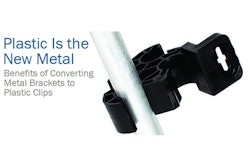About one year ago today, Harvard School of Public Health released the results of a major study on the negative impact of poor indoor air quality (IAQ).1 The study was designed “to objectively quantify the impact of indoor environmental [quality] on higher order cognitive function, a driver of real-world productivity in office workers.”
According to the study, “people who work in well-ventilated offices with below-average levels of indoor pollutants and carbon dioxide (CO2) have significantly higher cognitive functioning scores — in crucial areas such as responding to a crisis or developing strategy — than those who work in offices with typical levels.” This suggests that overall worker productivity is enhanced in a setting where indoor pollutants are below average.
The researchers indicated they examined the impacts of such things as ventilation, chemicals (such as cleaning chemicals), and carbon dioxide on workers’ cognitive function because, “as buildings have become more energy efficient, they have also become more airtight, increasing the potential for poor indoor environmental quality.”
This double-blind study — meaning participants did not know whether they were in a setting with positive or negative IAQ — was a comparison of the impacts of a facility that is “green,” where cleaning chemicals, for instance, have been certified as environmentally preferable and have a reduced impact on human health, versus one that uses “non-green,” or traditional, cleaning products that can impact health and with it, worker productivity.
IAQ: Foundation of the Green Cleaning Movement
The first green certification organizations, GreenSeal and ECOLOGO for example, formed in the late 1990s. Before GreenSeal and ECOLOGO, several manufacturers “self-certified” cleaning products as green; but what one manufacturer claimed was “green” about its product did not match the criteria used by another manufacturer producing a similar product used for the same purpose. Further, often there was no independent, third-party validation for the certification and very few had multi-attribute considerations
This caused a lot of confusion for consumers in industrial and other settings and, if not corrected, threatened to slow the entire green cleaning movement. GreenSeal and ECOLOGO, as well as other green certification organizations, stepped in to address this confusion, and they ultimately can be credited with creating the foundation for the green cleaning movement. Their belief was that if generally accepted standards and criteria were developed to determine whether a product is green, it could help end confusion, promote the green cleaning movement, and at the same time, address some of the problems caused by cleaning chemicals, such as negative health impacts and by poor IAQ, such as reduced worker productivity.
Confusion Caused by Green Certification Organizations
Although GreenSeal and ECOLOGO were the first green certification organization, others have since joined the certification movement. Among them are UL Environment and its GREENGUARD Program and the Safer Choice/Design for the Environment (DfE) program created by the U.S. Environmental Protection Agency.
While these organizations have essentially eliminated the “self-certification” practices mentioned earlier — in which a manufacturer claims its product to be green based on the company’s own criteria — along with the confusion this practice has caused for consumers, the multitude of certifying bodies has resulted in another problem. Now, most consumers believe these programs are all about the same. A product certified by GreenSeal, for instance, is believed to be similar to a product certified by Safer Choice/DfE. After all, don’t they have essentially the same standards and criteria for determining whether a cleaning product is green?
Although it is true there are many similarities in the standards and criteria used by these different organizations, where the difference lies is in the focus of each certification organization.
Focusing on the Focus
To better understand the problem, consider the following scenario:
You are the administrator of an industrial cleanroom. Workers are required to wear protective clothing from head to toe and breathing masks. Several steps have been taken to prohibit airborne contaminants from impacting the work being performed in the cleanroom. The ventilation system installed is designed specifically for use in a cleanroom setting.
Yet a problem remains. Air samples indicate there are airborne impurities in the cleanroom. Not only could this impact the work being performed, but because it is such a small, tightly enclosed setting, the health and productivity of the technicians in the cleanroom could be affected as well.
One of the steps taken to address this situation is to evaluate how the cleanroom is cleaned and which products are used. It is determined that the cleaning is being performed properly and effectively and that the chemicals used to clean the floors, work areas, counters, and other areas are green certified … indicating they should be helping to protect the IAQ.
However, here is where focus comes into play. While the products may all be green, not all the certification organizations make protecting IAQ their chief concern. For instance, GreenSeal plays a dominant role in the professional cleaning industry, but their big concern now is overall human health and sustainability; ECOLOGO is less focused on cleaning solutions and works with a wide range of products serving many industries. GREENGUARD, on the other hand, is primarily focused on IAQ and identifying those products that are proven more protective of IAQ.
With this in mind, I would advise the cleanroom administrator to do the following:
- Test different green-certified products made by the current manufacturer; it is possible that other products from this manufacturer will correct the problem.
- Test green-certified products from different manufacturers.
- Test green-certified products that are Green Seal or ECOLOGO certified, and/or GREENGUARD certified. (Multiple certification option should yield the best results regarding the impacts of IAQ)
- Retest air samples two or more weeks after the new products have been introduced. Once a product has been found most effective in reducing impurities in the air, evaluate it as to performance and price.
The last point needs further discussion. Although most green-certified products perform as well as or better than traditional cleaning solutions, they are not all the same. Some may work better than others on certain types of surfaces, different soil types, or different soil loads. In one case, a cleaning manager tested 23 green-certified floor care products before he found one that worked specifically on his organization’s floors. The same could be true for other types of products.
And while the products will likely be in the same general price range, be sure to evaluate dilution ratios. One, for instance, may be a less costly product to purchase but require a dilution ratio of one part chemical to five parts water. Another more costly product may only need to be diluted one part chemical to ten parts water. In such a case, while the second product is more costly to purchase, ultimately, it is the less expensive option.
Mike Sawchuk is chief business development officer for Avmor, a manufacturer and marketer of professional cleaning products in North America. He can be reached through his company website at www.avmor.com.
1 Allen JG, et al. “Associations of Cognitive Function Scores with Carbon Dioxide, Ventilation, and Volatile Organic Compound Exposures in Office Workers: A Controlled Exposure Study of Green and Conventional Office Environments.” Environmental Health Perspectives. 2016 Jun;124(6):805-812. DOI: 10.1289/ehp.1510037. Epub October 26, 2015.]























